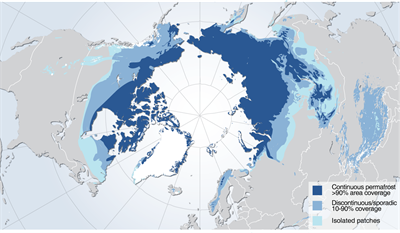April 9, 2014 – A new study opens with the following statement: “Carbon release due to permafrost thaw represents a potentially major positive climate change feedback.” I can just see climate change skeptics jumping on the words “positive climate change” thinking that this is no doubt a good thing. Well one person’s positive, in this case the research results, has enormous negative consequences for all on this planet. You see this positive they talk about is related to additional methane (CH4) and carbon dioxide (CO2) release into the atmosphere from permafrost melt. So they are talking about a net gain in greenhouse gases (GHGs) accelerating their concentration and contributing to even more significant global warming.
What is permafrost? It is ground frozen by temperatures below 0 Celsius (32 Fahrenheit) degrees. Any ground that stays in this state for two or more years is defined as permafrost. Permafrost can be found in Alaska, Russia, Canada, northern Scandinavia, Iceland and Greenland. In parts of Siberia permafrost goes to depths of 1,500 meters (5,000 feet). In northern Alaska some areas reach depths of 740 meters (almost 2,500 feet).
Permafrost can be found in mountainous areas as well. In Tibetan China alpine permafrost extends 1,500,000 square kilometers (580,000 square miles). There is even subsea permafrost with it forming in the cold depths of the Arctic and Southern Ocean that encircles Antarctica.
Permafrost has been here on the planet on numerous occasions. This latest occurrence is associated with the last glacial event lasting from 100,000 to 20,000 years ago. It is estimated that there is between 200,000 and 500,000 cubic kilometers (49,000 to 122,000 cubic miles) of icy permafrost currently on the planet. About 75% of it is near the surface and it is this permafrost that represents the immediate climate change impactor.
When soil freezes the biology consisting of aerobic and anaerobic bacteria becomes trapped. Some dies, some goes to sleep, and some remains active. Scientists have discovered viable bacteria in Arctic permafrost that dates back 3 million years. The ratio of aerobic and anaerobic bacteria varies depending on where the permafrost forms. For example, permafrost that is deep or in frozen lake and ocean bottom sediments tends to be anaerobic, whereas near-surface permafrost tends to be dominated by aerobic bacteria.
When temperatures warm to above freezing all of the microbiology contained within the thawing ground becomes very active. This is the source of permafrost CH4 and CO2, and in addition to the burned carbon we humans pump into the atmosphere every day will become a significant player in the greenhouse affect.
The new study explains just how the thawing mechanism impacts the release of the two gases. When permafrost first melts the release of CO2 to CH4 is 10:1. But the thawing process alters the chemistry of the organic matter leading to increased production of CH4 with the ratio of the two gases becoming equal. CH4 is 30 times more potent as a greenhouse gas than CO2. Releases of that gas from permafrost over a warming Arctic will only accelerate atmospheric heating which means even faster decomposition from the defrosting soil. CH4 oxidizes within a decade. But the volume that permafrost releases will be of a magnitude not seen on Earth for millions of years.
Recently I wrote about the latest theory on what caused the Great Dying some 252 million years ago when more than 90% of life on Earth vanished. The suspected cause, Methanosarcina, a microbe that ate its way through organic deposits in ocean sediments releasing vast amounts of CH4 of which the evidence can be found in fossilized sediments from the period. Will our burning of carbon and the subsequent warming of the Arctic permafrost be equally disruptive to life on the planet? Or can we reduce our carbon footprint and lessen the melting to keep climate change in check?












